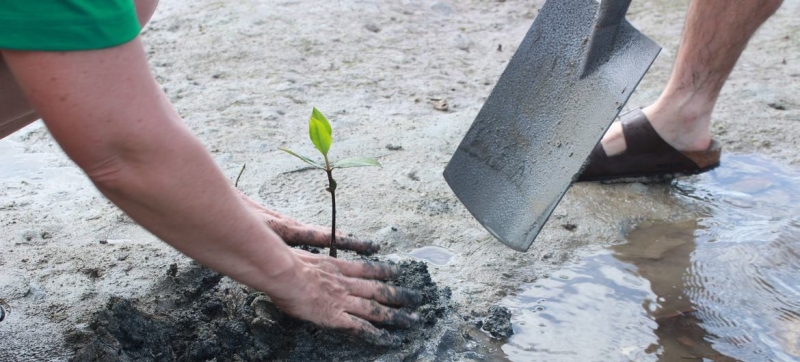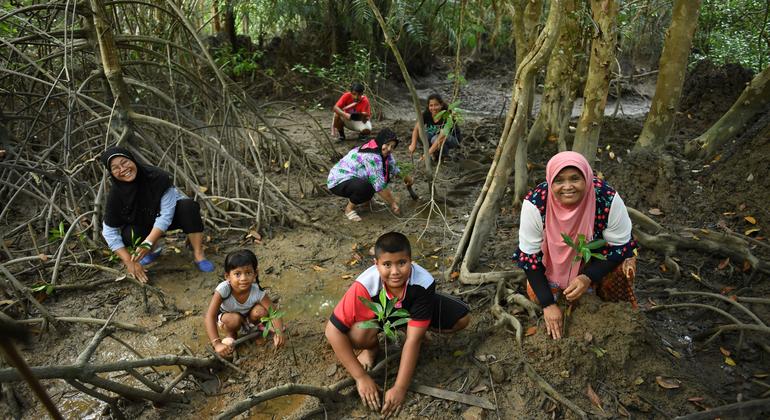
Mangrove forests are extremely valuable coastal ecosystems. The UN awarded seven ecosystem restoration projects Climate and Environment
The United Nations Environment Program (UNEP) and the Food and Agriculture Organization of the United Nations (FAO) have recognized seven ecosystem restoration projects in Africa, Latin America, the Mediterranean and South Asia as the best. The initiatives target ecosystems that are on the verge of complete degradation as a result of wildfires, drought, deforestation and pollution. The UN will provide technical and financial support for their implementation.
In total, the seven winning projects are expected to restore almost 40 million hectares and create about 500 thousand jobs.
A sustainable development model for the Mediterranean
The Mediterranean Basin is the world’s second largest biodiversity hotspot, but 16 percent of its forest species are at risk of extinction, partly due to longer periods of drought, extreme heat and wildfires driven by climate change. Over the past decade, the region has experienced its worst fire season on record.
The Mediterranean Forest Restoration Initiative involving Lebanon, Morocco, Tunisia and Turkey represents a new approach to protection and restoration of these natural habitats and vulnerable ecosystems and has led to the restoration of nearly two million hectares of forest across the region since 2017, with more than eight million hectares planned for restoration by 2030.
Living Indus: Restoring the Cradle of Civilizations
The 3,180 km long Indus River served as a vibrant center of social, cultural and economic life in what is now Pakistan for over 5,000 years. About 90 percent of Pakistan’s population and more than three-quarters of its economy lie in the Indus River basin, and the river irrigates more than 80 percent of the country’s arable land. Neglect, environmental degradation and climate change have threatened the river’s ecosystem, including its fisheries and fertile lands.
The Living Indus Initiative was approved by the Parliament of Pakistan following the devastating floods caused by climate change in 2022 and officially launched at the UN Climate Change Conference in Sharm El Sheikh (COP27). The initiative aims to restore 25 million hectares of river basin by 2030, covering 30 percent of Pakistan, through 25 high-impact interventions involving policymakers, practitioners and civil society. The initiative recognizes the Indus River as a living entity with rights, a measure taken to protect rivers in other countries, including Australia, Bangladesh, Bolivia, Brazil, Canada, Ecuador, India, New Zealand, Peru and Sri Lanka.
Acción Andina: saving the world’s water and climate hotspot
The social movement Acción Andina is led by the Peruvian environmental non-profit organization ECOAN (Andino Ecosystem Association). The movement advocates for expanding the community-based reforestation model, which has proven over the past two decades to be a cost-effective solution for building resilience to a changing climate. The plans include activities aimed at restoring and growing 30 million trees by 2030 in a strip of vegetation covering almost 800 thousand hectares in Argentina, Bolivia, Chile, Colombia, Ecuador, Peru and Venezuela.
The ultimate goal of the initiative is to protect and restore one million hectares of forest. 25 thousand people from remote Andean communities are already involved in efforts to restore five thousand hectares and protect more than 11 thousand hectares of Andean forest. By 2030, they are expected to benefit from the initiative in a variety of ways, from access to medical supplies, solar panels and clean clay kilns to improved rangeland management, sustainable agriculture, micro-businesses and ecotourism based on indigenous culture. In addition, the initiative works to secure land ownership rights for local communities, protecting forests from future mining, timber exploitation and other factors that cause degradation.
Sri Lanka : mangrove forests
In Sri Lanka, mangrove forests are extremely valuable coastal ecosystems that serve as an important link between marine and terrestrial biodiversity. The livelihoods of coastal communities in Sri Lanka are largely dependent on marine and coastal ecosystems. However, climate change and human activities pose threats to this unique ecosystem.
The Sri Lanka Mangrove Restoration Initiative is based on scientific evidence, led by the collaborative efforts of local communities, and aims to restore the natural balance of the ecosystem. Since the initiative launched in 2015, work has already resulted in the restoration of 500 hectares of mangroves, benefiting 150 households. By 2030, it is planned to restore about 10 thousand hectares, which will benefit five thousand households and create more than four thousand new jobs.

Terai Arc: Revival of Asian Megafauna
More than seven million people depend on the Terai Arc, which stretches over 2.47 million hectares and is shared by India and Nepal. It is also one of the most important habitats for tigers in the world, whose numbers have declined sharply, along with other species such as rhinoceroses and elephants, as a result of poaching, habitat loss, degradation, and human-wildlife conflict.
The Terai Arc Initiative focuses on reforestation in critical areas of the region; it involves close cooperation with the local population. The restoration of 66,800 hectares, along with other measures, has supported the area’s tiger population, which has now increased to 1,170 animals – three times the lowest level when the program began in 2001.
The recovery program improved the living conditions of approximately 500 thousand households and created 40 thousand new jobs. Development is expected to continue as nearly 350 thousand hectares are restored by 2030.
African Agriculture Revival
The Africa Rising Initiative has used proven reclamation techniques, tailored to the needs of farmers in diverse socio-ecological contexts over the past two decades, to restore more than 350,000 hectares in Ethiopia, Ghana, Kenya, Mali, Niger, Rwanda, Senegal and Somalia. By 2030, another five million hectares are planned to be restored.
The initiative is expected to benefit more than 600 thousand households. In addition, the initiative helps increase carbon sequestration; increase the productivity of agricultural crops and grasses; strengthen the soil (prevent flooding) and treat it with fixed nitrogen, which acts as a natural fertilizer.
Growing forests in the dry lands of Africa
Launched in 2015, the Forest Gardens Program includes many projects in Cameroon, Central African Republic, Chad, Gambia, Kenya, Mali, Senegal, Uganda and Tanzania. Through research into agroforestry methods, unsustainable farming practices are being replaced and nature is being restored by providing farmers with the necessary training, supplies and equipment to achieve successful results.
The initiative aims to increase the area from 41 thousands of hectares restored today to 229 thousand hectares by 2030, supporting many more people by creating 230 thousand jobs.
UN Decade on Ecosystem Restoration
The UN General Assembly declared 2021-2030 the UN Decade for Ecosystem Restoration. Led by the UN Environment Program and the Food and Agriculture Organization of the UN, and with the support of partners, it aims to prevent, halt and reverse the loss and degradation of ecosystems around the world. The movement aims to revitalize billions of hectares spanning both terrestrial and aquatic ecosystems.
